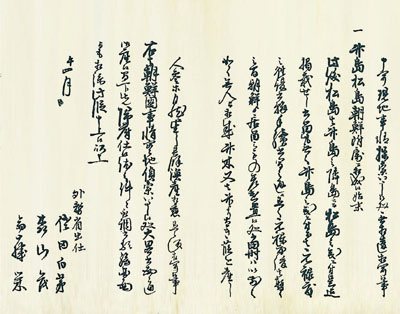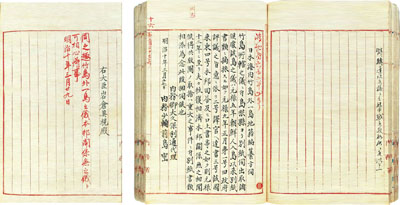- Dokdo in the East Sea
- Controversies surrounding Dokdo
- Ten Truths about Dokdo Not Known in Japan
Dokdo in the East Sea
Table of Contents Open Contents
- Ten Truths about Dokdo Not Known in Japan
- 1. Japan claims it has long recognized the existence of Dokdo.
- 2. Japan claims there is no evidence that Korea recognized the existence of Dokdo in the past
- 3. Japan claims that it established its sovereignty over Dokdo in the mid-seventeenth century.
- 4. Japan claims that it banned passage to Ulleungdo in the late seventeenth century, but did not ban passage to Dokdo
- 5. Japan claims that Ahn Yong-bok’s statement is not reliable
- 6. Japan claims Japan reaffirmed its intention to claim sovereignty over Dokdo by incorporating the island into Shimane Prefecture in 1905
- 7. Japan claims that while drafting the San Francisco Peace Treaty the United States suggested that Dokdo is under the jurisdiction of Japan
- 8. Japan claims the designation of Dokdo as a bombing range for military practice for the United States Forces in Japan shows that Dokdo was treated as part of Japan’s territory
- 9. Japan claims that the Republic of Korea is illegally occupying Dokdo
- 10. Japan claims although Japan proposed to the Republic of Korea to refer this dispute over Dokdo to the International Court of Justice, the Republic of Korea rejects doing so.
Japan claims it has long recognized the existence of Dokdo.
Japan’s recognition is confirmed by a variety of written documents and maps, including “The Revised Complete Map of Japanese Lands and Roads” (Kaisei Nihon yochi rotei zenzu, 1846), compiled by Nagakubo Sekisui.
Japan’s claims is not true because...
Japan has long recognized Dokdo as Korean territory.
The Japanese government presents “The Revised Complete Map of Japanese Lands and Roads” as proof for its claim that Japan has long recognized Dokdo as Japanese territory. However Dokdo and Ulle ungdo are located outside the longitudinal and latitudinal lines of the grid in the 1846 edition of this map and in the original edition completed in 1779. Further, the text “Records on Observation in Oki Province” (Inshu shicho goki) includes a sentence which states that the Oki Islands form the northwestern border of Japan. (See Material 1.) This statement indicates that Dokdo had not been recognized as Japanese territory.
Further, there are several old maps published by the Japanese government, including “The Map of Japanese Coastal Areas” (Dai Nihon enkai yochi zenzu), completed in 1821 by Ino Tadataka, which did not mark Ulleungdo and Dokdo as parts of Japanese territory. “The Complete Map of Joseon” (Joseon zenzu) which was completed in 1876 and published by the Advisory Bureau of the Japanese Army, places the two islands within Joseon’s territory.
Official Japanese government documents also clearly show that Japan had not recognized Dokdo as its territory until its illegal incorporation of the island in 1905. A report written by an official of the Foreign Ministry of Japan after investigating Joseon, “Confidential Inquiry into the Particulars of Korea’s Relations with Japan” (Joseon-koku kosai shimatsu naitansho), which was dated 1870, discusses Ulleungdo and Dokdo under the title “The Background of How Takeshima and Matsushima became Annexed to Joseon.” Here, “Takeshima” refers to Ulleungdo and “Matsushima” refers to Dokdo. This text, too, shows that Dokdo was perceived as Joseon’s territory, not as Japan’s territory. (See Material 2.)
In 1877, the Japanese Ministry of Internal Affairs received an inquiry regarding whether to include Ulleungdo and Dokdo into the land register of Shimane Prefecture. In response to this inquiry, Japan’s most authoritative government office at that time, the State Council (Dajokan), issued an order which stated, “Concerning the inquiry about Takeshima and the other island, it is to be understood that this country [Japan] has nothing to do with them,” based upon the Edo Shogunate’s prohibition of passage to Ulleungdo in the late seventeenth century. Here, “Takeshima” referred to Ulleungdo and “the other island” referred to Dokdo. Some Japanese scholars argue that “the other island” in this order is not Dokdo. However, “The Simplified Map of Isotakeshima” (Isotakeshima ryakuzu), completed in 1877 and submitted by Shimane Prefecture to the Ministry of Internal Affairs, made it clear that “the other island” was Matsushima, that is, Dokdo. (See Material 3.)
-
- MATERIAL 1. “The Revised Complete Map of Japanese Lands and Roads” (Kaisei Nihon yochi rotei zenzu) (Original edition dated 1779)
-
- MATERIAL 2. “Confidential Inquiry into the Particulars of Korea’s Relations with Japan”(Joseon-koku kosai shimatsu naitansho), dated 1870
-
 “Confidential Inquiry into the Particulars of Korea’s Relations with Japan”(Joseon-koku kosai shimatsu naitansho), dated 1870 The background to how Takeshima (that is, Ulleungdo) and Matsushima (that is, Dokdo) became annexed to Joseon.
“Confidential Inquiry into the Particulars of Korea’s Relations with Japan”(Joseon-koku kosai shimatsu naitansho), dated 1870 The background to how Takeshima (that is, Ulleungdo) and Matsushima (that is, Dokdo) became annexed to Joseon.
“Matsushima [that is, Dokdo] is an island next to Takeshima [that is, Ulleungdo]. No records regarding Matsushima exist, but letters exchanged in the late seventeenth century include comments relating to Takeshima [that is, Ulleungdo]. For some time since the late seventeenth century, Joseon had sent people to reside in Takeshima [that is, Ulleungdo], but now it has become an uninhabited island again. It is heard that bamboo, reeds that are thicker than bamboo, and ginseng grow there. Fish may be caught, too. This record is based upon our local investigation. We will report this together with our investigation documents, illustrations, and maps by topic after returning to Japan.”
The diplomatic mission of Sada Hakubo, Moriyama Shigeru, and Saito Sakae in April, 1870
-
- MATERIAL 3. The State Council (Dajokan) Order and the Attached Map “The Simplified Map of Isotakeshima” (Isotakeshima ryakuzu), dated 1877
-
 The Simplified Map of Isotakeshima(Isotakeshima ryakuzu)“Joseon is approximately fifty leagues(ri) northwest of Isotakeshima [that is, Ulleungdo].”
The Simplified Map of Isotakeshima(Isotakeshima ryakuzu)“Joseon is approximately fifty leagues(ri) northwest of Isotakeshima [that is, Ulleungdo].”
“Isotakeshima [that is, Ulleungdo] is approximately forty leagues northwest of Matsushima [that is, Dokdo].”
“Matsushima [that is, Dokdo] is eighty leagues northwest of Fukuura, in the Oki Islands.”










